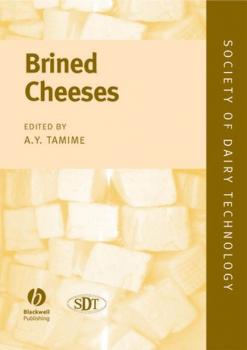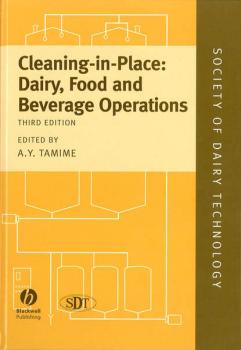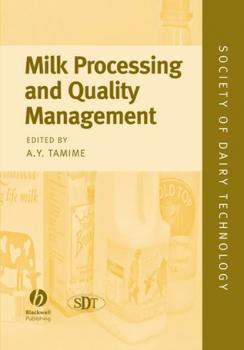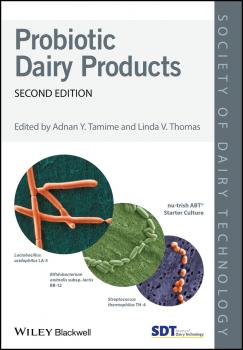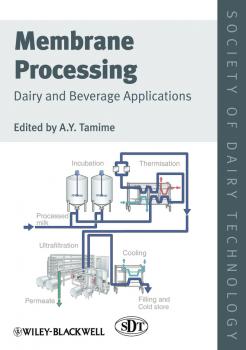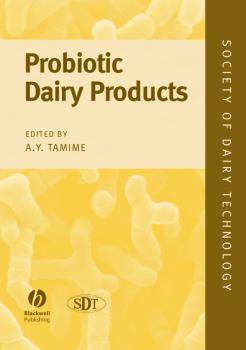ТОП просматриваемых книг сайта:
Adnan Tamime Y.
Список книг автора Adnan Tamime Y.Аннотация
Highly profitable and an important range of products within the dairy industry worldwide, the economic importance of fermented milks continues to grow. Technological developments have led to a wider range of products and increased popularity with consumers. In the second book to feature in the SDT series Fermented Milks reviews the properties and manufacturing methods associated with products such as yoghurt, buttermilk, kefir, koumiss milk-based fermented beverages and many other examples from around the globe, offering the reader: A practically-oriented and user-friendly guide Key commercially important information Coverage of all the major stages of manufacture Background to each product Edited by Adnan Tamime, with contributions from international authors and full of core commercially useful information for the dairy industry, this book is an essential title for dairy scientists, dairy technologists and nutritionists worldwide.
Аннотация
The Society of Dairy Technology (SDT) has joined with Blackwell Publishing to produce a series of technical dairy-related handbooks providing an invaluable resource for all those involved in the dairy industry; from practitioners to technologists working in both traditional and modern larged-scale dairy operations. Brined cheeses such as feta and halloumi have seen a large increase in popularity and as a result, increasing economic value. Over the past two decades the dairy industry has carried out much research into starter cultures alongside technological developments, widening the range of brined cheese products available to consumers worldwide. The third title in the SDT series, Brined Cheeses gathers research on this important range of cheese varieties from around the world into a single volume, offering the reader: A practically-oriented and user-friendly guide Key commercially important information Coverage of all the major stages of manufacture Background to each variety Review of how different varieties are utilised in different countries Edited by Adnan Tamime, with contributions from international authors and full of core commercially useful information for the dairy industry, this book is an essential title for dairy scientists, dairy technologists and nutritionists worldwide.
Аннотация
This is the third edition of the Society of Dairy Technology's highly successful volume on Cleaning-in-Place (CIP). Already a well-established practice in dairy technology, CIP has become increasingly relevant in the processed food industry during the last 10-15 years, and the beverage industry has seen increased demands from customers regarding CIP verification and validation to provide improvements in plant hygiene and related efficiency. The book addresses the principles of cleaning operations, water supply issues and the science of detergents and disinfectants. Aspects of equipment design relevant to ease of cleaning are covered in a special chapter, as is the assessment of cleaning efficiency and the management of cleaning operations. This third edition features for the first time a chapter on membrane cleaning – a relatively new area requiring very specialised cleaning products and procedures. Useful data on fluid flow dynamics and laboratory test methods are also included in separate chapters. Authors have been selected from within industry, allied suppliers and academia to provide a balanced, leading edge assessment of the subject matter. Cleaning-in-Place is directed at dairy scientists and technologists in industry and academia, general food scientists and food technologists, food microbiologists and equipment manufacturers.
Аннотация
Structure of Dairy Products SOCIETY OF DAIRY TECHNOLOGY SERIES Edited by A. Y. Tamime The Society of Dairy Technology (SDT) has joined with Blackwell Publishing to produce a series of technical dairy-related handbooks providing an invaluable resource for all those involved in the dairy industry; from practitioners to technologists working in both traditional and modern large-scale dairy operations. The previous 30 years have witnessed great interest in the microstructure of dairy products, which has a vital bearing on, e.g. texture, sensory qualities, shelf life and packaging requirements of dairy foods. During the same period, new techniques have been developed to visualise clearly the properties of these products. Hence, scanning electron microscopy (SEM) and transmission electron microscopy (TEM) have been used as complimentary methods in quality appraisal of dairy products, and are used for product development and in trouble shooting wherever faults arise during manufacturing. Structure of Dairy Products, an excellent new addition to the increasingly well-known and respected SDT series, offers the reader: • information of importance in product development and quality control • internationally known contributing authors and book editor • thorough coverage of all major aspects of the subject • core, commercially useful knowledge for the dairy industry Edited by Adnan Tamime, with contributions from international authors, this book is an essential purchase for dairy scientists and technologists, food scientists and technologists, food chemists, physicists, rheologists and microscopists. Libraries in all universities and research establishments teaching and researching in these areas should have copies of this important work on their shelves.
Аннотация
The Society of Dairy Technology (SDT) has joined with Wiley-Blackwell to produce a series of technical dairy-related handbooks providing an invaluable resource for all those involved in the dairy industry; from practitioners to technologists working in both traditional and modern large-scale dairy operations. The fifth volume in the series, Milk Processing and Quality Management, provides timely and comprehensive guidance on the processing of liquid milks by bringing together contributions from leading experts around the globe. This important book covers all major aspects of hygienic milk production, storage and processing and other key topics such as: Microbiology of raw and market milks Quality control International legislation Safety HACCP in milk processing All those involved in the dairy industry including food scientists, food technologists, food microbiologists, food safety enforcement personnel, quality control personnel, dairy industry equipment suppliers and food ingredient companies should find much of interest in this commercially important book which will also provide libraries in dairy and food research establishments with a valuable reference for this important area.
Аннотация
Probiotic Dairy Products, 2nd Edition The updated guide to the most current research and developments in probiotic dairy products The thoroughly revised and updated second edition of Probiotic Dairy Products reviews the recent advancements in the dairy industry and includes the latest scientific developments in regard to the 'functional' aspects of dairy and fermented milk products and their ingredients. Since the publication of the first edition of this text, there have been incredible advances in the knowledge and understanding of the human microbiota, mainly due to the development and use of new molecular analysis techniques. This new edition includes information on the newest developments in the field. It offers information on the new ‘omic’ technologies that have been used to detect and analyse all the genes, proteins and metabolites of individuals’ gut microbiota. The text also includes a description of the history of probiotics and explores the origins of probiotic products and the early pioneers in this field. Other chapters in this resource provide valuable updates on genomic analysis of probiotic strains and aspects of probiotic products’ production and quality control. This important resource: Offers a completely revised and updated edition to the text that covers the topic of probiotic dairy products Contains 4 brand new chapters on the following topics: the history of probiotics, prebiotic components, probiotic research, and the production of vitamins, exopolysaccharides (EPS), and bacteriocins Features a new co-editor and a host of new contributors, that offer the latest research findings and expertise Is the latest title in Wiley's Society of Dairy Technology Technical Series Probiotic Dairy Products is an essential resource for dairy scientists, dairy technologists and nutritionists. The text includes the results of the most reliable research in field and offers informed views on the future of, and barriers to, the progress for probiotic dairy products.
Аннотация
Food-borne diseases, including those via dairy products, have been recognised as major threats to human health. The causes associated with dairy food-borne disease are the use of raw milk in the manufacture of dairy products, faulty processing conditions during the heat treatment of milk, post-processing contamination, failure in due diligence and an unhygienic water supply. Dairy food-borne diseases affecting human health are associated with certain strains of bacteria belonging to the genera of Clostridium, Bacillus, Escherichia, Staphylococcus and Listeria, which are capable of producing toxins, plus moulds that can produce mycotoxins such as aflatoxins, sterigmatocytin and ochratoxin. Microbial Toxins in Dairy Products reviews the latest scientific knowledge and developments for detecting and studying the presence of these toxins in dairy products, updating the analytical techniques required to examine bacterial and mould toxins and the potential for contamination of milk as it passes along the food chain, i.e. from 'farm-to-fork'. This comprehensive and accessible collection of techniques will help dairy processors, food scientists, technologists, researchers and students to further minimise the incidences of dairy food-borne illnesses in humans.
Аннотация
In the last two decades, there have been significant developments in membrane filtration processes for the dairy and beverage industries. The filtration systems can be classified into four main groups: reverse osmosis, nanofiltration, ultrafiltration and microfiltration. The primary objective of this book is to assess critically the pool of scientific knowledge available to the dairy and beverages industry, as a tool for process and product innovation, quality improvement and safety. The book is divided into three main parts. Part I reviews the principals, developments and designs of membrane processes that are mainly used in commercial dairy and beverage applications. Part II provides information on the applications of membrane processes in the manufacture of dairy products, from on-farm concentration of milk as a pre-treatment for cheesemaking to fractionation of milk and whey to provide ingredients for food and other applications. Part III considers membrane applications during the manufacture of fruit juices, beer and cider, wine and vinegar. These include concentration, deacidification and dealcoholisation processes. Membrane Processing: Dairy and Beverages Applications is an ideal new reference for dairy and beverage processors involved in the application of membranes, both to aid the creation of novel products, and to improve their process economics. Students and lecturers of food and dairy science and technology will value its in-depth discussion of membrane processes, whilst readers based in the dairy industry will prize it as the most up-to-date and advanced volume yet published on this crucially important topic.
Аннотация
Following significant developments in recent understanding of milk systems and an explosion in interest in the use of probiotics and prebiotics as functional foods Probiotic Dairy Products looks at advancements in the dairy industry and reviews the latest scientific developments in regard to the ‘functional’ aspects of dairy and fermented milk products and their ingredients. The first title in Blackwell Publishing’s prestigious Society of Dairy Technology Series, this key text includes coverage of: Production systems Gut microflora Genomic characterisation of probiotic micro-organisms Physical properties associated with health claims Maintenance of the viability of probiotic products National and international statutory regulations Edited by Adnan Tamime, with contributions from international authors and full of core commercially useful information for the dairy industry, this book is an essential title for dairy scientists, dairy technologists and nutritionists worldwide.
Аннотация
Part of the Society of Dairy Technology Series, this book deals with a commercially significant sector of dairy science. The book includes chapters on legislation, functionality of ingredients, processing plants and equipment, manufacturing best practice, packaging, and quality control. The chapters are authored by an international team of experts. This book is an essential resource for manufacturers and users of processed and analogue cheese products internationally; dairy scientists in industry and research; and advanced food science students with an interest in dairy science.


